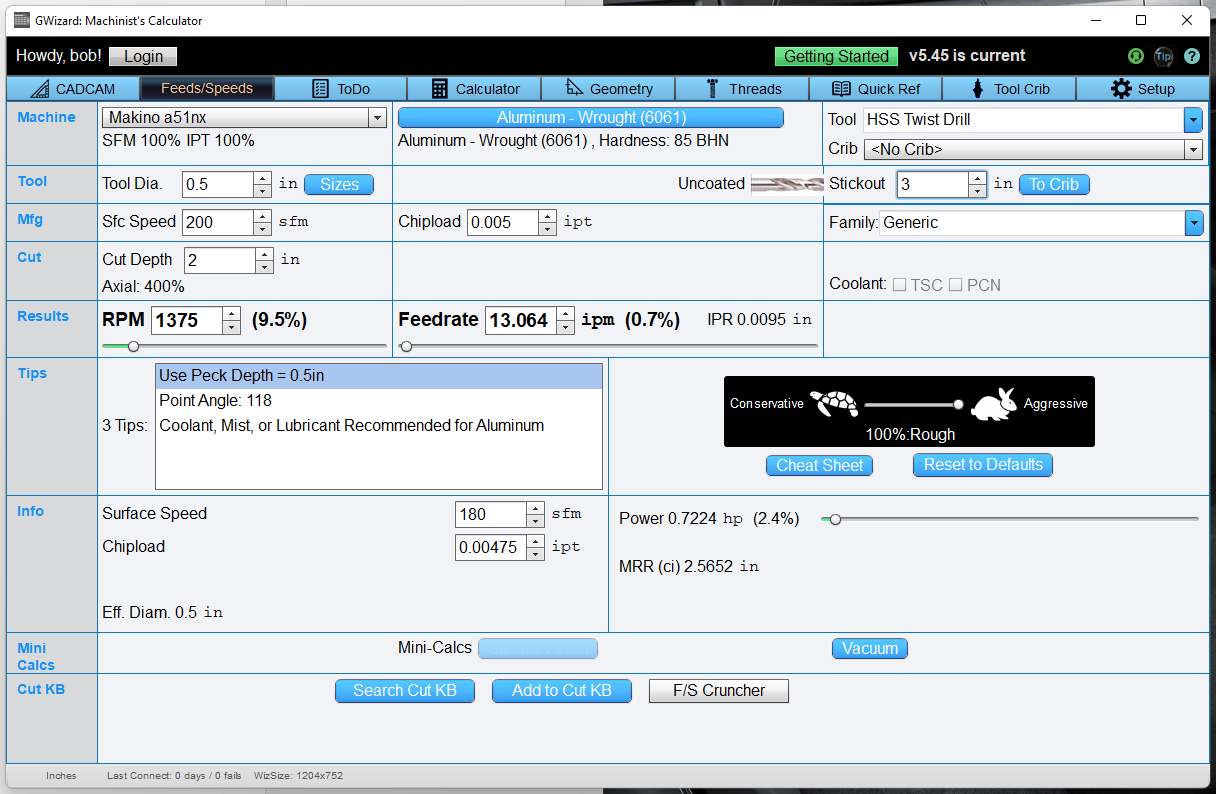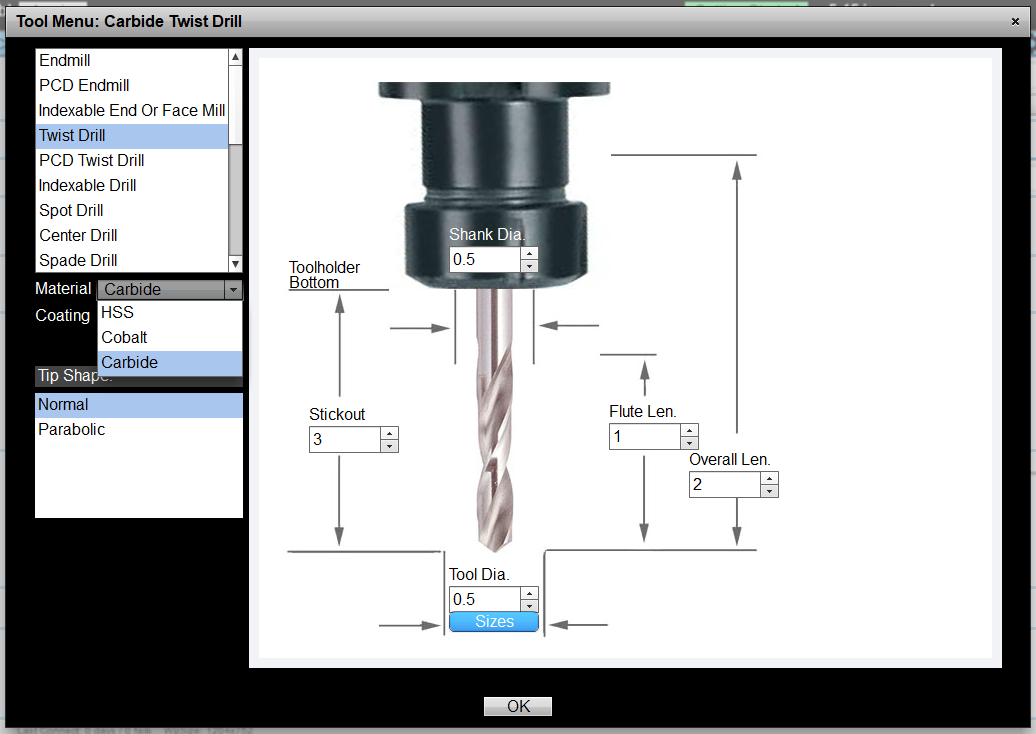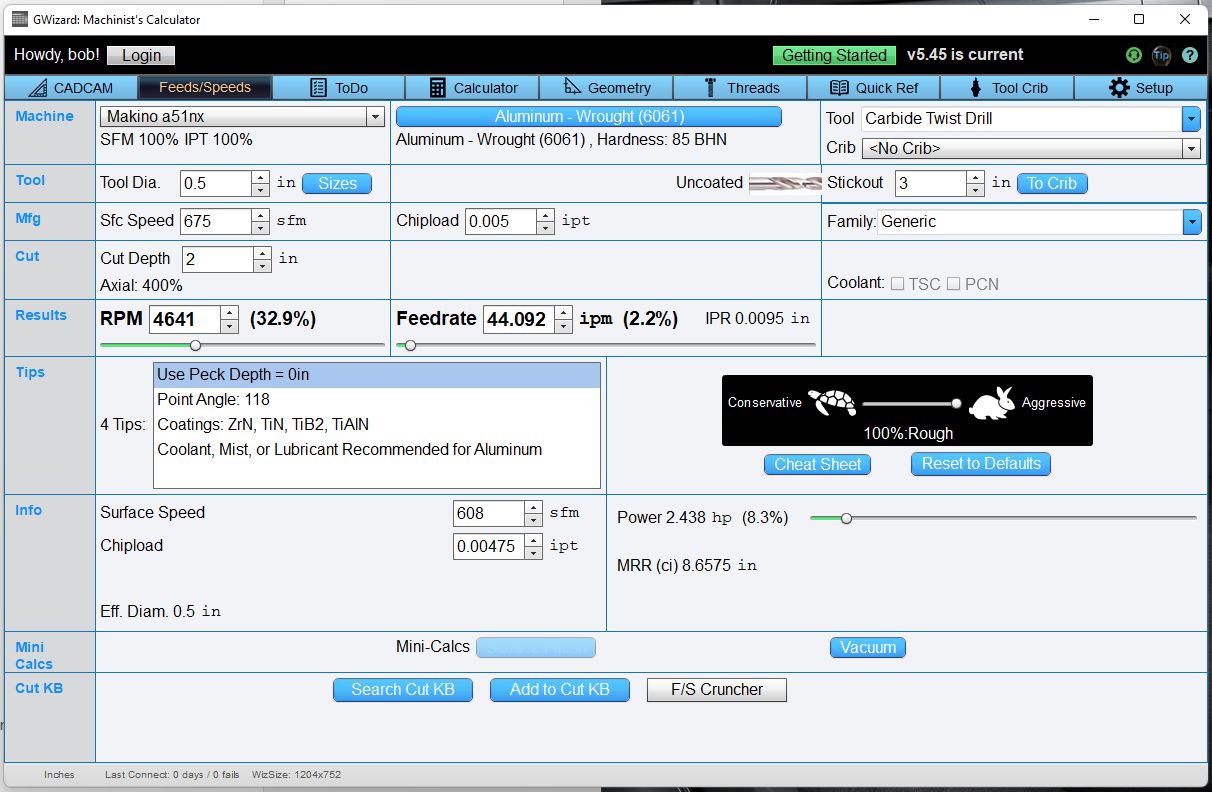Recently I had breakfast with a gentleman who was telling me his tale of woe. He had to drill hundreds of holes in some steel electrical panels on his CNC Router, and things were not going well.
Tool life on his drill bits in particular was terrible. Knowing that CNC Router spindles typically run too fast for HSS and Cobalt drills, as well as that Carbide Drill Speeds and Feeds can be run a lot faster and have longer tool life to boot, I suggested he try Carbide.
Low and behold, it worked like a champ, and the next time I saw him he bought me my breakfast in thanks.
What is a Solid Carbide Drill?
Carbide is the toughest material you can make a twist drill from. It is much harder than high speed steels (and Cobalt too). It can withstand a lot more heat as well as being harder. But it is also the most brittle material.
Because it is so brittle, it should be reserved for production drilling using a high quality tool holder and drilling machine. Solid Carbide Drills are not suitable for hand drills, and even drill presses are not ideal. Stick to Cobalt and HSS drills for those applications.
Carbide can outlive cobalt by 10-20 times. If you're able to get 100 holes from your Cobalt Drills, you should expect to get 1000 to 2000 holes with a Solid Carbide Drill.
They can also run 3-5x faster, due to their being able to run at much higher SFM values. Because of their enhanced life and speed, the cost per hole is usually the lowest with Carbide.
Carbide Drill Features
Coatings (TiN, TiCN, TiAlN)
A good coating can add considerably to the performance of your Carbide Drills.
Through Spindle Coolant
HSS drills can only go to 2-3x diameters deep then they must peck. Carbide can drill up to 5x diameter before needing to peck.
The problem with peck drilling is it increases tool wear. Most tool wear occurs at the beginning of a cut. Peck drilling restarts the cut with every peck. In addition it is much slower to peck.
Peck drilling also makes work hardening much worse.
With Through Spindle Coolant (TSC), coolant is fed through internal passages in the Carbide Drill. It emerges at the very tip of the drill where it can do the most good in aiding cooling and chip evacuation.
Combining TSC with high pressure coolant produces even more effective performance gains.
Proper use of TSC and High Pressure Coolant can eliminate the need for peck drilling altogether.
For more information on Peck Drilling, see the linked article. You may also find our article on Deep Hole Drilling to be helpful.
Geometry
Length:
Length is one of the first Geometry attributes to consider when selecting a drill. Most drills are available in Screw Machine (Stub Length), Jobber Length, and Custom Lengths. The shorter the length, the more rigid the Drill and the more precise it will be. To ensure proper chip clearance, the Flute Length must be long enough so you have flutes 2x the diameter above the hole.
Drill Point Angle:
118 degree is common or wider 135 to 140 degrees are also available. Much more on Drill Bit Angles in our dedicated article on the subject.
You can look up the best point angle in references like the Machinery’s Handbook, or you can use our G-Wizard Calculator to tell you the right point angle for any given material you’ve chosen:

G-Wizard recommends either a split or notched point with a 135 degree angle for 300 series stainless steel…
Helix Angle:
A 30 degree helix angle is good for General Purpose Drilling. Smaller helix angles (down to 10 degrees) for harder steels and aluminum alloys. Large angles (up to 40 degrees) for tough materials.
Self-Centering Point (aka Split Point):

Regular point on the left, split point on the right…
Eliminates the need for a starting drill. Eliminates walk when cutting. No need to spot drill!
Parabolic Flutes:
Most Carbide Drills will come equipped with Parabolic Flutes. They reduce the need for peck drilling and provide higher performance. For more on Parabolic Flute Drills, see the linked article.
Specialized Types: Center Drill and Spot Drill
You can purchase both a carbide center drill as well as a carbide spot drill. I'm less enamored of the center drills, but a spot drill in carbide will last a long time and do a great job for you.
Carbide Drill Speeds and Feeds
If you're ready to spend the money for quality Carbide Drills, be sure you have high-quality Feeds and Speeds to work with them. Our G-Wizard Calculator is the perfect complement for your Carbide Drills.
As mentioned, it will tell you the optimum point angle for the material you're working with. But it can do a lot more besides.
If you’ve ever used G-Wizard Calculator to try to figure feeds and speeds for deeper holes, you may have noticed it recommending a “Parabolic”:

G-Wizard thinks you’ll have problems with this hole if you don’t use a Parabolic Flute drill…
As a matter of fact, GW Calculator will tell you quite a few interesting things to improve your twist drilling including when you need to use a Peck cycle (where the twist drill is retracted periodically as it moves down the hole to break chips) and what point angle will work best with your chosen material.
Once G-Wizard gives you a warning, it means you’re likely to have problems if you try to drill the hole without the requested drill geometry. Geometry is they key word in this case, and you can get G-Wizard to calm down and give you some feeds and speeds by popping open the Geometry window and selecting Parabolic flutes.
So what are the governing these recommendations?
G-Wizard uses the following rules when making depth-based suggestions about holes:
– At 4x diameter, it will start asking you to peck drill.
– At 8x diameter, it will ask for parabolic flutes
– At 20x diameter, it’s become a black art. Time for some sort of custom Deep Hole Cycle g-code programming and maybe a call to your tooling dealer for something that’s probably either very expensive or very slow.
As you can see, there’s some complexity involved with any hole more than a few diameters deep. The reason the Parabolic Flute Drill can help is its unique flute design. Here we can compare standard versus parabolic flutes side by side:
The big deal on the parabolics is the faster spiral. I’ve marked the same number of turns in the diagram, and we can see that for a given number of turns, the parabolic will have moved the chips further up the helix due to its faster spiral. Parabolic drills often have other geometry advantages including more room in the flute for more chips and a wider web on the tip for greater durability.
Parabolics are quite a bit more expensive than the average jobber length twist drills, but for deep holes, they’re darned well worth it. They may even be worth it in shallower depths just because of the increased feedrates they can bring.
Here are the G-Wizard feeds and speeds for a 1/2″ HSS twist drill going 2″ deep in 6061 aluminum:

Regular Twist Drill feeds and speeds…
The Material Removal Rate is 2.57 cubic inches per minute. Now, let’s try that same hole with a Carbide Drill. To change, click the Tool button:

Just select “Carbide” from the Material menu…
Here are the feeds and speeds with a Carbide Drill:

The MRR goes from 2.57 to 8.66 cubic inches per minute with a Carbide drill.
If you haven’t tried our G-Wizard Feeds and Speeds calculator, get a free 30-day trial. Not only does it make these useful recommendations such as when you need a parabolic drill, it does a whole lot more besides!
[ Check Out the G-Wizard Calculator ]
Carbide Drill Tips and Techniques
- The increased rigidity of Carbide Drills versus HSS means they have better positional and dimensional accuracy. If your Carbide Drill includes a self-centering point, there is typically no need to use a spotting drill.
- To further maximize rigidity, use the shortest possible drill length for the job at hand.
- Slow just before the drill point breaks through the material. Slow for the final 2mm.
- Carbide may not be the best investment for short runs. You won't have time to dial it in.
- Because of their brittleness, avoid peck drilling unless the hole is so deep that it's unavoidable.
- Increasing feedrate can often help break chips into smaller pieces if your getting long stringy chips.
- If you're having problems with the occasional wad of chips hanging from the drill at the end of a cycle, try programming a quick reverse spindle run. You can often fling that wad away before it gets tangled up with the tool changing arm.
More Feeds and Speeds Calculators
-
G-Wizard Feeds and Speeds Calculator
-
Milling Speeds and Feeds Calculator
-
CNC Feed Rate Calculator
-
Chip Load Calculator
-
Simple Feeds and Speeds Calculator
-
Lathe Feeds and Speeds Calculator
-
Drill Feeds and Speeds Calculator
-
Tapping Feeds and Speeds Calculator
-
Master Feeds and Speeds Calculator List
Be the first to know about updates at CNC Cookbook
Join our newsletter to get updates on what's next at CNC Cookbook.